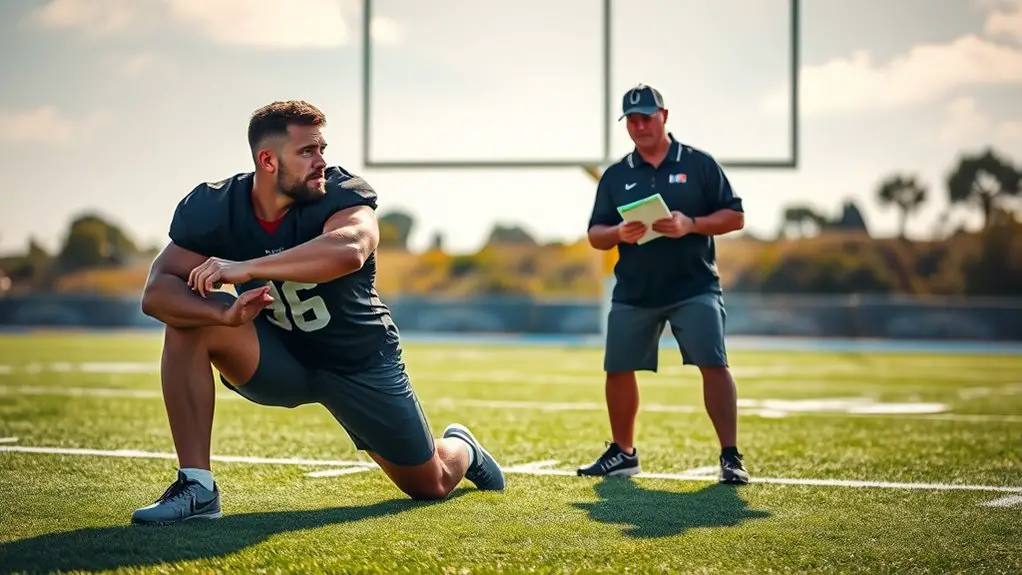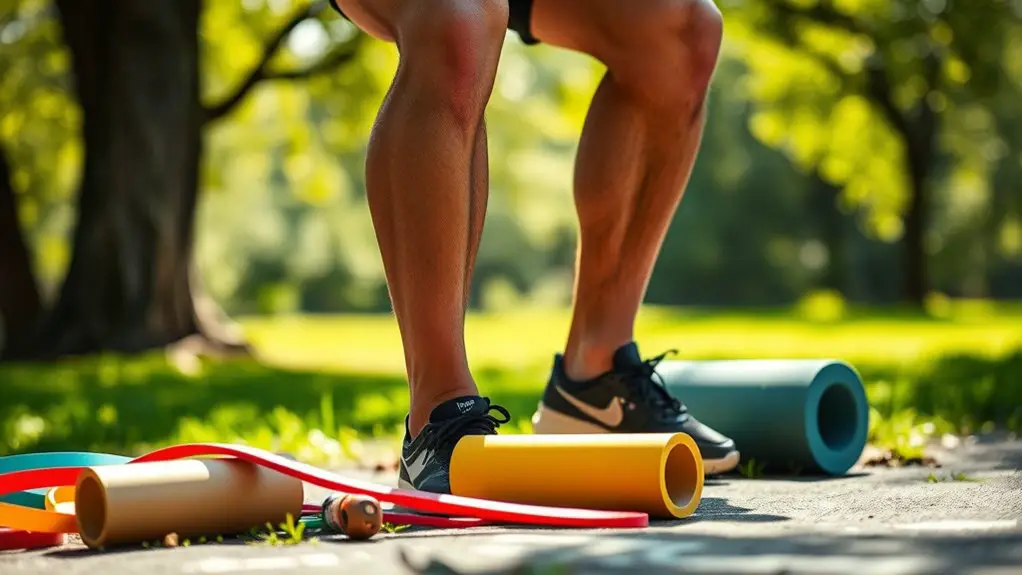Mobility exercises are vital for your performance as a lineman. They boost flexibility, strength, and agility, which helps you execute critical plays effectively. Improved mobility can reduce your risk of injuries like ankle sprains and knee ligament strains, ensuring you stay on the field longer. By incorporating these exercises into your routine, you'll enhance your overall athleticism and game readiness. Discover how to implement these exercises and access your full potential.
The Role of Linemen in Football
Although linemen often operate behind the scenes, their role is essential to a football team's success. You might not see them in the spotlight, but the linemen responsibilities are vital for both offense and defense. On the offensive line, you need to protect the quarterback and create openings for running backs. This requires sharp linemen strategies, including communication and quick decision-making.
Defensively, linemen are your team's first line of defense, fighting to disrupt the opposing team's plays. You must execute techniques like shedding blocks and maintaining gap integrity to keep your team strong. It's about more than just brute strength; it's about technique and teamwork. When linemen embrace their responsibilities and strategize effectively, they create a powerful foundation for the entire team. Additionally, mastering footwork drills can significantly enhance a lineman's agility and overall performance. So, remember, the next time you watch a game, appreciate the linemen's role in paving the way for victory.
Understanding Mobility and Its Importance
Mobility is a vital aspect of athletic performance, especially for linemen in football. You might think mobility is just about flexibility or static stretching, but that's a common misconception. It's about how freely your body can move, which directly impacts your strength and agility on the field. Dynamic stretching plays an essential role here; it prepares your muscles for action and enhances your range of motion.
When you improve your mobility, you're not only reducing the risk of injury but also revealing your full potential. Think of it as creating a pathway for your body to move efficiently. By addressing mobility, you'll find yourself more agile and powerful during those intense plays. Additionally, enhanced flexibility and range of motion allows for fluid movements, which can give you a competitive edge. So, don't underestimate the importance of mobility exercises—embracing them can truly elevate your game, giving you the freedom to perform at your peak.
Key Benefits of Mobility Exercises
Mobility exercises offer essential benefits that can elevate your performance on the field. You'll find that enhanced flexibility and range of motion not only improve your functional strength but also play a key role in injury prevention. By incorporating these exercises into your routine, you're setting yourself up for greater success and longevity in the game. Additionally, prioritizing mobility training helps maintain joint health and promotes better movement patterns, further enhancing your overall athleticism.
Enhanced Flexibility and Range
When you incorporate mobility exercises into your training routine, you're not just warming up; you're greatly enhancing your flexibility and range of motion. This newfound freedom allows you to move more fluidly on the field, giving you an edge over opponents. Dynamic stretching is key, as it activates your muscles and prepares them for explosive movements. Don't forget foam rolling, too; it helps release tightness, promoting better muscle recovery and overall mobility. With improved flexibility, you can execute plays with precision and agility, letting you respond to the fast-paced nature of the game. Embracing these exercises empowers you to perform at your best, breaking free from limitations and revealing your true potential as a lineman.
Injury Prevention Strategies
While you might focus on strength and power as a lineman, neglecting mobility exercises can leave you vulnerable to injuries. By incorporating dynamic warm-ups into your routine, you enhance your body's readiness for the physical demands of the game. These exercises increase blood flow to your muscles, improve your range of motion, and activate the joints, reducing injury risk during intense plays. You'll find that greater mobility helps you navigate the field with more freedom and agility, allowing you to react swiftly to opponents. Prioritizing mobility not only keeps you on the field but also empowers you to play at your best. Embrace these strategies, and you'll pave the way to a more resilient and injury-free season.
Improved Functional Strength
Improved functional strength is one of the most significant benefits of incorporating mobility exercises into your training regimen. When you focus on mobility, you enhance your ability to perform functional movements that translate directly to the field. Here are some key aspects of how mobility exercises boost your strength training:
- Increased Range of Motion: Greater flexibility allows for deeper and more powerful movements.
- Enhanced Neuromuscular Coordination: Improved connections between your brain and muscles lead to better overall performance.
- Balanced Muscle Development: Mobility work helps prevent muscle imbalances, allowing you to lift and push more effectively.
- Injury Resistance: A strong, mobile body is less prone to injuries, giving you the freedom to perform at your best.
Embrace mobility, and watch your functional strength soar.
Common Injuries Among Linemen
As a lineman, you're at a higher risk for certain injuries that can sideline your performance. Common issues like knee ligament strains, shoulder dislocations, and ankle sprains can greatly impact your game. Understanding these injuries is essential for prevention and recovery, so let's explore them further. Incorporating proper warm-ups and stretching into your routine can significantly reduce the likelihood of these injuries.
Knee Ligament Strains
Knee ligament strains are among the most common injuries linemen face on the field. These injuries often result from the high-impact nature of the game, affecting your knee stability and overall performance. To keep your ligament health in check, consider the following tips:
- Strengthen the surrounding muscles: Focus on quadriceps and hamstrings to support your knees.
- Incorporate mobility exercises: Regularly practice stretches and dynamic movements to maintain flexibility.
- Use proper techniques: Always employ correct form during drills and tackles to reduce strain.
- Rest and recover: Listen to your body and give yourself time to heal when necessary.
Shoulder Dislocations
In addition to knee ligament strains, shoulder dislocations are another prevalent injury linemen encounter on the field. These dislocations often stem from impacts and awkward falls, limiting your shoulder mobility and overall performance. To combat this, incorporating dynamic warm-ups into your routine can increase flexibility and strength.
| Exercise | Benefits |
|---|---|
| Arm Circles | Improves shoulder mobility |
| Resistance Band Pulls | Strengthens shoulder stabilizers |
| Wall Slides | Enhances range of motion |
| Scapular Push-Ups | Builds shoulder strength |
| Dynamic Chest Stretch | Prepares muscles for play |
Ankle Sprains
Ankle sprains are one of the most common injuries linemen face during games and practices. These injuries can limit your mobility and hinder your performance on the field. To boost ankle stability and enhance sprain prevention, consider these key strategies:
- Strength Training: Focus on exercises that strengthen the muscles around your ankles.
- Balance Drills: Incorporate single-leg stands and balance boards to improve stability.
- Flexibility Work: Regularly stretch the calf and Achilles tendons to maintain range of motion.
- Proper Footwear: Invest in supportive shoes that provide adequate cushioning and grip.
Essential Mobility Exercises for Linemen
While linemen often focus on strength and power, incorporating crucial mobility exercises can greatly enhance their performance on the field. To achieve this, start with dynamic stretching, which warms up your muscles and increases your range of motion. Movements like leg swings and arm circles are great to incorporate into your routine. They'll not only prepare your body for action but also help prevent injuries.
Foam rolling is another critical tool you shouldn't overlook. By rolling out tight muscles, you promote better blood flow and flexibility, making it easier for you to move explosively during games. Focus on areas like your hips, quadriceps, and calves, as they often bear the brunt of your intense training. Additionally, proper warm-up techniques are essential for reducing the risk of hamstring injuries and optimizing performance.
Together, these exercises can free up your body, allowing you to perform at your peak while reducing the risk of injury. Embrace mobility as a key component of your training regimen!
Integrating Mobility Training Into Practice
To effectively enhance your performance, integrating mobility training into your practice routine is essential. Embracing this approach not only boosts your flexibility but also allows you to move freely on the field. Here's how you can seamlessly incorporate mobility exercises:
- Start with Dynamic Warm Ups: Engage in dynamic warm ups to prepare your muscles and joints, improving blood flow and reducing injury risk.
- Schedule Regular Flexibility Drills: Dedicate time within your practice to focus on flexibility drills that target key muscle groups, ensuring greater range of motion.
- Combine Strength and Mobility: Integrate mobility exercises into strength training sessions, allowing you to build power without sacrificing flexibility.
- Cool Down with Stretching: After practices, use stretching techniques to enhance recovery and maintain flexibility, setting you up for success in future sessions. A strong core enhances stability and balance, which is crucial for executing mobility exercises effectively.
Measuring Progress and Effectiveness
Integrating mobility training into your practice is just the beginning; measuring progress and effectiveness is key to ensuring these exercises are truly benefiting your performance. You need to implement progress tracking and effectiveness metrics to see how far you've come and where you need to go. A well-structured approach like Functional Movement Screening can help highlight areas needing attention and guide your training.
Here's a simple table to help you get started:
| Metric | Description | Frequency |
|---|---|---|
| Range of Motion | Measure joint flexibility | Weekly |
| Performance Tests | Track agility and strength | Bi-weekly |
| Subjective Feedback | Self-assess mobility changes | After each session |
Nutrition and Recovery for Optimal Mobility
Proper nutrition and recovery are vital for enhancing mobility, as they fuel your body and facilitate the healing process. To achieve ideal mobility, focus on these key elements:
- Nutrient Timing: Eat a balanced meal with carbs and protein pre- and post-workout. This helps in muscle repair and energy replenishment.
- Hydration: Staying hydrated is essential. Water supports joint lubrication and can improve your overall performance. Additionally, hydration supports optimal performance by regulating body temperature and transporting nutrients.
- Recovery Protocols: Implement techniques like foam rolling, stretching, and adequate sleep to help your muscles recover and maintain flexibility.
- Anti-Inflammatory Foods: Incorporate foods rich in omega-3 fatty acids, like salmon and walnuts, to reduce inflammation and promote healing.
Real-Life Success Stories of Enhanced Performance
While many athletes focus on training regimens and nutrition, real-life success stories often highlight the transformative power of targeted mobility exercises for linemen. Take Jake, for instance. He struggled with stiffness and poor agility, but after incorporating mobility drills into his routine, his performance metrics skyrocketed. Coaches noted his improved footwork and quicker reaction times during games.
Then there's Maria, who faced similar challenges. By dedicating time to mobility exercises, she revealed newfound freedom in her movements, allowing her to dominate on the field. Real-life testimonials like theirs prove that these exercises aren't just optional; they're essential. This emphasis on flexibility and mobility fosters freedom of movement in sports.
When you embrace mobility training, you're not just enhancing your performance; you're setting yourself free to move more fluidly and confidently. So, if you're looking to elevate your game, consider the stories of those who've transformed their performance through targeted mobility work.
Frequently Asked Questions
How Often Should Linemen Perform Mobility Exercises During the Week?
"You can't put a limit on anything. The more you dream, the farther you get." For linemen, aiming for peak performance means integrating mobility exercises into your routine. Ideally, you should perform these exercises three to four times a week, dedicating about 20 to 30 minutes each session. This weekly frequency and peak duration will help enhance your flexibility and overall movement patterns, giving you the freedom to excel on the field.
Can Mobility Exercises Help Prevent Injuries for Linemen?
Absolutely, mobility exercises can greatly aid in injury prevention for linemen. By incorporating these movements into your routine, you'll enhance your flexibility benefits, allowing for greater range of motion. This increased flexibility reduces the risk of strains and sprains during intense gameplay. Plus, being more mobile means you can react quicker and move more freely, giving you the freedom to perform at your best while staying safe on the field.
What Equipment Is Needed for Effective Mobility Workouts?
For effective mobility workouts, you don't need much—just some essential mobility tools. A foam roller, resistance bands, and a yoga mat can enhance your stretching routines greatly. Incorporating these tools helps you target tight areas and improve flexibility, giving you the freedom to move better. You'll find that adding these elements to your training not only enhances your mobility but also keeps your workouts fresh and engaging.
Are There Specific Mobility Exercises for Different Positions in Linemen?
Ever wondered if those position-specific stretches could elevate your game? For linemen, focusing on joint mobility drills tailored to your role is essential. Offensive linemen benefit from hip openers and ankle mobility work, while defensive linemen might prioritize thoracic spine rotations. By incorporating these targeted mobility exercises, you'll not only enhance your flexibility but also improve your overall performance, giving you the freedom to dominate on the field. Your body will thank you!
How Can Coaches Incorporate Mobility Training Into Daily Practices?
To incorporate mobility training into daily practices, you can start with dynamic stretching as part of your warm-up. This gets everyone moving and ready for action. Set aside time for mobility drills, focusing on key areas like hips and shoulders. You might even create fun competitions to make it engaging. Remember, keeping it light and enjoyable helps build a routine that players will look forward to, enhancing their overall performance on the field.




